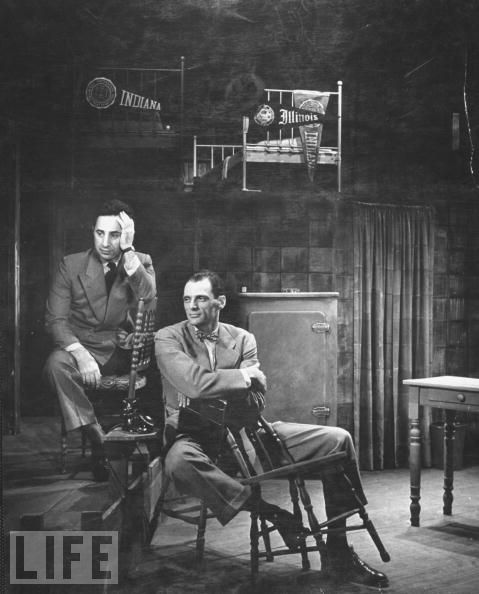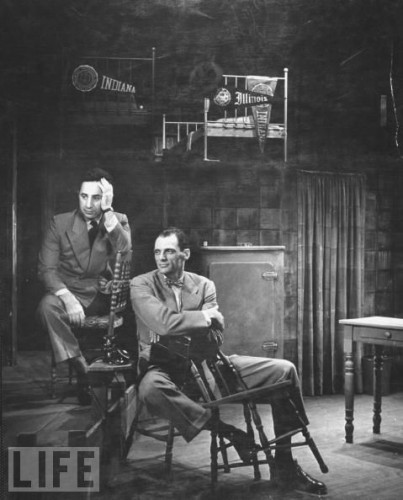The following is an article about Joe Lynn, a twentieth-century American props master I have written about frequently on this blog. It comes from a 1943 issue of The New Yorker:
by Eugene Kinkead and Russell Maloney
A local stage property man named Joe Lynn is, we would guess, the most zealous prop man in the business. A prop man, you know, takes care of everything in a theatrical production that isn’t part of the set or a member of Actors’ Equity—dishes, weapons, rubies stolen from an idol’s eye, or whatever. The job also includes taking care of letters, if letters are called for in the script. In “The Eve of St. Mark” a letter figures prominently in Act I, Scene 3. As the scene opens, a girl is just finishing a letter to her sweetheart in the Army. She seals it and gives it to her father to mail. Well, Joe Lynn is the prop man for “The Eve of St. Mark.” Every day, and twice a day on matinée days, he has written a real letter for the use of Mary Rolfe, who plays the girl, and she has added a few words of her own before sealing it. There’s no need for any of this super-realism, you understand; a sheet of paper with a few random scribbles on it would be good enough to fool even the people in the front row.
The letters thus composed are kept stacked on a shelf backstage at the Cort—quite a pile of them now, the show having played over two hundred and fifty performances. Joe Lynn, a stocky fellow in his mid-forties, allowed us to skim through and transcribe a few selections, though it was plain that he thought our interest was misplaced. “I don’t go in much for this literary business,” he told us, busily stacking away a plateful of dummy hamburgers. “I just catch-as-catch-can with it. It never takes me more than three or four minutes.” Having read a few of the letters, we decided that Joe was being too modest. The letters, most of them on current events, were uniformly pithy, studded with cracks like this one, apropos the rumor that the Little Flower was going to join the Army: “Well, it happened. We now have a one-star general direct from City Hall. I’d like to see him in his uniform. I’ll bet he will look like a wet football standing on end.” One day last week the letter read, “Now they’ve knocked Rommel’s ears back. On our own shores Congress has been kicking around the Ruml Plan. I guess some of them figured any thing or name that sounded like Rommel was no good, and they wanted to share in the glory.”
On the twelfth of February there was a brief tribute to Lincoln, beginning, “One hundred and thirty-four years ago today Nancy Hanks lying on a rough-hewn bed with an old rough bearskin as a mattress gave birth to a baby boy who was later to become the Great Emancipator.” Other topics touched on in the letters are liquor rationing, the Supreme Court, Valentine’s Day, the old Tiller Girls, General MacArthur, and the Shubert brothers. Miss Rolfe’s additions to these notes, having been made onstage, are naturally somewhat perfunctory. Usually they have no relation to Joe’s topic of the day; for instance, her post-script to Joe’s letter on liquor rationing read, bleakly, “Well, here I go with another cold. Love, Janet.” All the letters begin with the salutation “Dear Quizz” in Joe’s handwriting and end “Love, Janet” in Miss Rolfe’s. Quizz and Janet are, of course, the play’s lovers.
Joe had a forthright answer when we asked him why he goes to all this extra trouble. “I got to do something to earn my money,” he said. He figures that since 1915, when he started his career as a prop man, he has had about a hundred shows, probably half of which involved letters; during the runs of these shows he wrote letters for every performance. He has apparently established a tradition for “The Eve of St. Mark.” The prop man for the road company was furnished with a batch of Joe’s letters to use as models and ordered to do likewise, willy-nilly. Understand the theatre any better now?
Kinkead, Eugene, and Russell Maloney. “Correspondence.” The New Yorker, 22 May 1943, p. 14.


